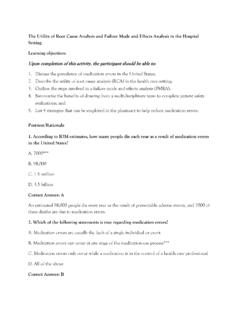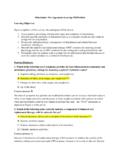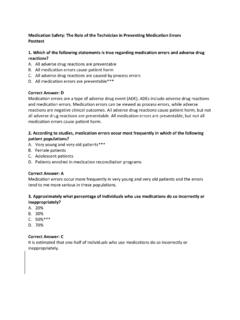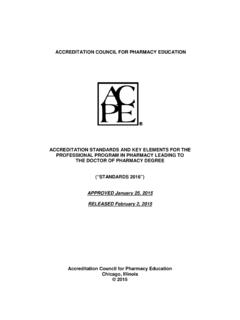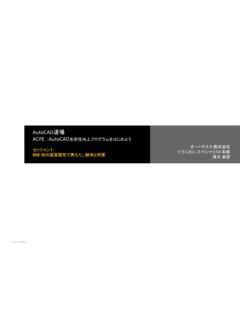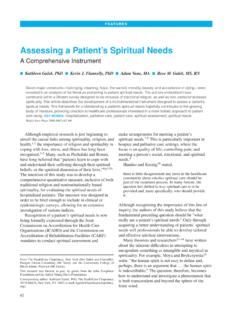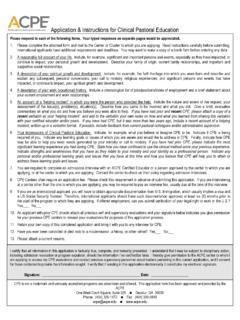Transcription of PHARMACY TECHNICIAN C.E. PROGRAM
1 2017-2018 Influenza Season: A Review for Pharmacists and PHARMACY TechniciansFACULTYC lark Kebodeaux, PharmD, BCACPC linical Assistant Professor University of Kentucky College of PHARMACY Lexington, KentuckyUAN: 0430-0000-17-079-H06-TCredits: hours ( ceu)GOALTo provide information on historical and new trends in influenza immunization that impact patient care, including updated recommendations provided by the Advisory Committee on Immunization Practices for the 2017-2018 influenza OBJECTIVESUpon completion of this activity, participants should be better able to:1. Define current and historical trends that impact influenza immunization recommendations2. Describe the Advisory Committee on Immunization Practices recommendations and updates that guide current influenza immunization practices3. Recognize appropriate influenza immunization-related recommendations for patients in special populations4.
2 Identify appropriate communication techniques to support influenza immunization recommendationsPharmacy Calculations for PHARMACY Technicians: Concentrations, Dilutions and Drug DosingFACULTYC asey J. Covrett, PharmD, BCPSF reelance Medical Writer Wilmington, North CarolinaREVIEWER/CONTENT ADVISORL aura K. Stinson, PharmDOwner and Director of Clinical Operations The Stinson Pen, LLC Lexington, TECHICIAN PROGRAM DESCRIPTIONS AND LEARNING OBJECTIVESEDITORIAL NOTE: Contributions to educational materials: Material released August 20, 2014 through August 20, 2017 under ACPE UAN 0430-0000-014-048-H04-T developed and written by Casey Covrett, PharmD, BCPS. Updated with additional writing and references in 2017 by Laura K. Stinson, PharmDUAN: 0430-0000-17-065-H04-TCredits: hours ( ceu)GOALThe goal of this activity is to improve the PHARMACY TECHNICIAN s ability to solve math problems related to drug concentrations, dilutions, and individualized drug OBJECTIVESUpon completion of this activity, participants should be better able to:1.
3 Apply the method of alligation when mixing solutions or solids with different percent strengths;2. Perform liquid and solid dilution calculations expressed in terms of weight-volume (w/v) and weight-weight (w/w);3. Calculate patient-specific drug doses based on ideal body weight, body surface area, and adjusted body weight; 4. Utilize the aliquot method in PHARMACY compounding when appropriate; and5. Verify IV flow rates to enhance patient General Chapter <800>: A PHARMACY Professional s Guide to Handling and Compounding Hazardous DrugsFACULTYP atricia C. Kienle, RPh, MPA, FASHPC ardinal Health Innovative Delivery SolutionsAngela G. Long, MS, MPH RightInsightUAN: 0430-0000-17-060-H07-TCredits: hours ( ceu)GOALTo present information on the practice issues, standards, and regulatory framework related to the handling of and compounding hazardous OBJECTIVESUpon completion of this activity, participants should be better able to:1.
4 State the purpose of the United States Pharmacopeia Chapter <800>, to whom it applies, and in what locations2. Identify the document that must be used to identify hazardous drugs3. Define the process for establishing an assessment of risk4. Cite the types of engineering controls appropriate for use with hazardous drugs5. List the type of environmental monitoring used to detect hazardous drug CALCULATIONS FOR PHARMACY TECHNICIANS: UNITS OF MEASUREMENT AND METHODS OF CALCULATION FACULTYC asey J. Covrett, PharmD, BCPSF reelance Medical Writer Wilmington, North CarolinaReviewer/Content AdvisorLaura K. Stinson, PharmDOwner and Director of Clinical Operations The Stinson Pen, LLC Lexington, KYEditorial Note: Contributions to educational materials: Material released July 1, 2014 through July 1, 2017 under ACPE UAN 0430-0000-014-027-H04-T developed and written by Casey Covrett, PharmD, BCPS.
5 Updated with additional writing and references in 2017 by Laura K. Stinson, PharmDUAN: 0430-0000-17-054-H04-T Credits: hours ( ceu) GOAL The goal of this activity is to enhance the PHARMACY TECHNICIAN s familiarity with calculations performed in the traditional PHARMACY practice setting. EDUCATIONAL OBJECTIVES Upon completion of this activity, participants should be better able to: 1. Determine quantities based on the Roman numeral system; 2. Solve PHARMACY -based math problems using dimensional analysis, fractional equations, and ratio-proportion methods of calculation; 3. Accurately convert units between metric and household systems of measurement; and 4. Calculate a day s supply of both oral solid and liquid dosage forms. EMERGENCY CONTRACEPTION: KEY CONCEPTS FOR THE PHARMACY TECHNICIAN FACULTY Laura Borgelt, PharmD, FCCP, BCPS, NCMP Associate Dean of Administration and Operations and Professor Departments of Clinical PHARMACY and Family Practice University of Colorado Anshutz Medical Campus Skaggs School of PHARMACY and Pharmaceutical Sciences Aurora, CO UAN: 0430-0000-17-052-H01-T Credits: hours ( ceu) OBJECTIVES Upon completion of this activity, participants should be better able to: 1.
6 Compare and contrast various methods of emergency contraception (EC) including their efficacy, mechanism of action, contraindications, dosing, potential drug interactions, and adverse effects; 2. Explain ongoing legislation regarding access and prescription status of EC; 3. dentify when EC would be recommended to a patient seeking EC; and 4. Identify when to refer patients for counseling with the pharmacist. USP GENERAL CHAPTER <797>: A GUIDE TO STERILE COMPOUNDING FOR PHARMACY PERSONNEL FACULTY Patricia C. Kienle, RPh, MPA, FASHP Cardinal Health Innovative Delivery Solutions Angela G. Long, MS, MPH RightInsight UAN: 0430-0000-17-041-H04-T Credits: hours ( ceu) GOAL To present requirements for establishing and maintaining policies, facilities, and personnel needed for production of sterile compounded preparations in accordance with laws, regulations, and standards in the United States.
7 LEARNING OBJECTIVES Upon completion of this activity, participants should be better able to: 1. List the key regulations, standards, and enforcement bodies for sterile compounding. 2. Identity the types of primary engineering controls used for nonhazardous and hazardous sterile compounding 3. State the two physical tests that must be successfully completed by compounders and the frequency the tests must be performed 4. Differentiate viable and nonviable testing for compounding facilities 5. List the work practices required when compounding sterile preparations. KEEPING UP WITH SUPPLY AND DEMAND: PHARMACY INVENTORY MANAGEMENT FACULTY Laura K. Stinson, PharmD Owner and Director of Clinical Operations The Stinson Pen, LLC Lexington, KY UAN: 0430-0000-17-052-H01-T Credits: hours ( ceu) NOTE Contributions to educational materials: Material released January 2015 through January 2017 under ACPE UAN 0430-0000-015- 003-H04-T developed and written by Casey Covrett, PharmD, BCPS.
8 Updated with additional writing and references in 2017 by Laura K. Stinson, PharmD. UAN: 0430-0000-17-034-H04-T Credits: hours ( ceu) GOAL To educate PHARMACY technicians about effective and efficient inventory control practices in order to limit spoilage and improve patient care. EDUCATIONAL OBJECTIVES Upon completion of this activity, participants should be better able to: 1. Understand key inventory terminology and how it applies to daily practice; 2. Summarize steps to appropriately manage inventory when new drugs gain market entry and during brand-to-generic transitions; 3. Identify positive and negative events that affect inventory; and 4. Outline the goals of inventory management. THE EXPANDING ROLE OF THE PHARMACY TECHNICIAN MTM AND VACCINATION SUPPORT FACULTY Michael D. Hogue, PharmD, FAPhA, FNAP Professor and Chair Department of PHARMACY Practice McWhorter School of PHARMACY , Samford University Birmingham, Alabama UAN: 0430-0000-17-013-H04-T Credits: hours ( ceu) GOAL To review the roles of the PHARMACY TECHNICIAN in medication therapy management and vaccination support.
9 EDUCATIONAL OBJECTIVES Upon completion of this activity, participants should be better able to: 1. Identify the core elements of the medication therapy management process; 2. Describe how a PHARMACY TECHNICIAN can assist pharmacists to enable optimal patient care as part of the medication 3. therapy management process; 4. Articulate positive verbal queues which facilitate pharmacist-patient interaction resulting in vaccination of the patient; and 5. Describe the PHARMACY TECHNICIAN s role in appropriate vaccine storage and handling, pre-vaccination patient screening, and post-vaccination documentation and follow-up. SYSTEMS APPROACH TO IMPROVING MEDICATION SAFETY FACULTY Donna Horn, RPh, DPh Director, Patient Safety Community PHARMACY Institute for Safe Medication Practices Horsham, PA UAN: 0430-0000-17-034-H04-T Credits: hours ( ceu) GOAL To educate PHARMACY technicians about effective and efficient inventory control practices in order to limit spoilage and improve patient care.
10 EDUCATIONAL OBJECTIVES Upon completion of this activity, participants should be better able to: 1. Use the Institute for Safe Medication Practices (ISMP) Key Elements of the Medication Use System to identify and prevent risk in daily practice; 2. Describe how to analyze a medication error using a specific set of steps and associated tools to identify contributing factors and root causes of the event; 3. Specify how to use information gathered during root cause analysis to minimize the reoccurrence of medication errors; 4. Select effective error reduction strategies that can prevent patient harm and engage in practices that ensure patient safety. MAXIMIZING PATIENT INTERACTION AT THE PHARMACY COUNTER OTC MEDICATIONS FOR ALLERGIC RHINITIS AND THE COMMON COLD FACULTY W. Steven Pray, PhD, DPh Bernhardt Professor of PHARMACY Southwestern Oklahoma State University School of PHARMACY Weatherford, Oklahoma UAN: 0430-0000-17-010-H01-T Credits: hours ( ceu) GOAL The goal of this activity is to prepare PHARMACY technicians to assist pharmacists by eliciting appropriate and useful information from patients complaining of allergic rhinitis or the common cold.
